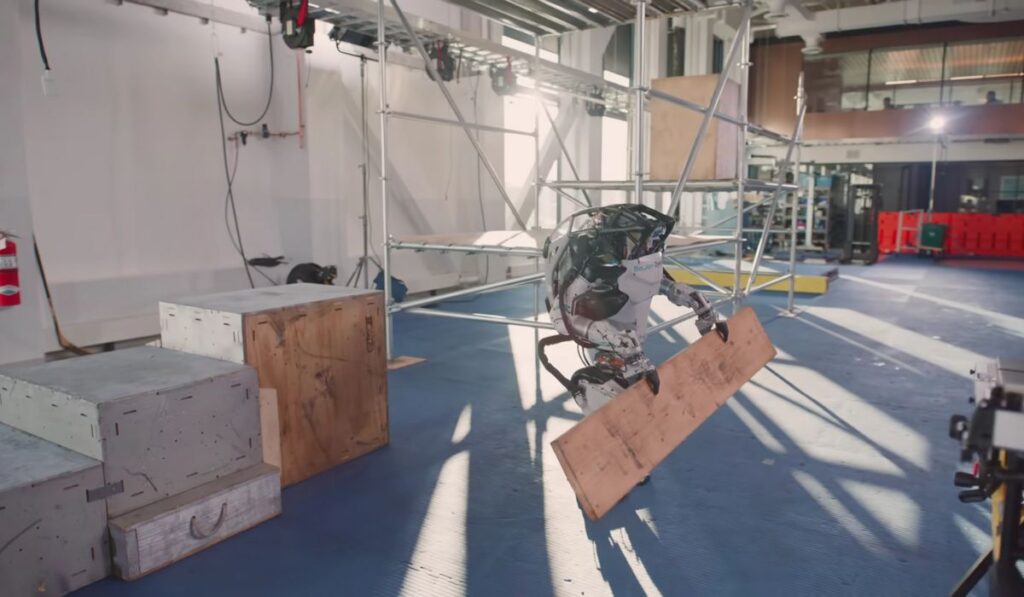Boston Dynamics engineers have pushed The humanoid robot Atlas from Boston Dynamics has recently dazzled the globe with its dance routines and navigated a challenging parkour course by jumping, hopping, and backflipping.
It’s time for Atlas to learn some new skills at this point.
In Boston Dynamics’ most recent video (see below), “Atlas Gets a Grip,” the robot manipulates the world around it: Atlas interacts with objects and modifies the course to reach its goal—delivering a bag of tools to a person waiting at the top of a multi-story scaffold. Atlas grabs, carries, and tosses the tool bag, climbs stairs, jumps between levels, and pushes a large wooden block out of the way before dismounting with an inverted 540-degree flip dubbed the “Sick Trick” by project engineers.
At first glance, the routine appears to be less flashy and more functional than previous videos. According to Ben Stephens, Atlas controls lead, the new moves are a natural progression of ongoing research.
“We’re layering on new capabilities,” Stephens says. “Parkour and dancing were interesting examples of pretty extreme locomotion, and now we’re trying to build upon that research to also do meaningful manipulation. It’s important to us that the robot can perform these tasks with a certain amount of human speed. People are very good at these tasks, so that has required some pretty big upgrades to the control software.”
Expanding the Toolkit
To anyone other than a roboticist, the ability to do a backflip (or even to dance a well-executed mashed potato) may seem more impressive than picking up and delivering a bag of tools. But a robot performing manipulation tasks requires a more nuanced understanding of its environment. The dancing in “Do You Love Me?” was entirely blind, without the perception needed for Atlas to respond to its environment. In “Partners in Parkour,” Atlas perceived and moved over and around fixed obstacles (in sometimes breathtaking fashion).
For this new routine, the robot’s locomotion and sensing capabilities come up against the added challenge of not only detecting, gripping, and moving objects with different sizes, materials, and weights, but also staying balanced while negotiating those objects through the world.
“Parkour forces us to understand the physical limitations of the robot, and dance forces us to think about how precise and dexterous the whole-body motion can be,” says Robin Deits, a software engineer on the Atlas controls team. “Now, manipulation is forcing us to take that information and interpret it in terms of how we can get the hands to do something specific. What’s important about the Atlas project is that we don’t let go of any of those other things we’ve learned.”
For Stephens, one of the most impressive sequences in the new routine is the opening, when Atlas manipulates a large wooden plank.
“There’s a lot going on, and it all happens very quickly,” he says. Instead of turning around cautiously, Stephens notes, Atlas performs a 180-degree jump while holding the plank, meaning that the robot’s control system needs to account for the plank’s momentum to avoid toppling over. “And then Atlas places it in exactly the right spot in the world, to use later.”

Pushing the wooden box off the platform is also a deceptively difficult task: Atlas must generate enough force to cause the box to fall while leaning into the shove without falling off the platform.
Even the flip at the end of the routine is more difficult than the previous acrobatics because the twist adds asymmetry that a regular backflip does not have. Not only is the math more difficult, but Atlas kept getting tangled in its own limbs as it tucked its arms and legs in trial runs, forcing engineers to troubleshoot and improve the control system so that it could choose strategies that avoided self collisions.
“We’re using all of the strength available in almost every single joint on the robot,” Deits says. “That trick is right at the limit of what the robot can do.”
Creating the Future
While some Boston Dynamics robots, such as Spot and Stretch, are available commercially, Atlas is purely a research platform. The Atlas team is dedicated to pushing the boundaries of what is possible. Atlas’ R&D advances can help improve the hardware and software of these other robots while also advancing toward a “go anywhere, do anything” robot capable of performing essentially all of the same physical tasks as a person.
Scott Kuindersma, Atlas team lead at Boston Dynamics, acknowledges that robots are unlikely to dip into their bag of gymnastics tricks at job sites.
“This is more a demonstration of some of the robot’s new control capabilities, and a fun connection to our prior work,” he says. “Our hope is that, if we can build the foundational technology that allows us to easily create and adapt dynamic behaviors like these, we should be able to leverage it down the road to perform real, physically-demanding jobs with hustle. There are many pieces required to deliver a complete solution in a domain like manufacturing or construction—this video highlights a narrow slice of what we’re working on.”
Stephens says that roboticists are still a “long way off” from creating humanoid robots that can routinely tackle dirty and dangerous jobs in the real world.
“Manipulation is a broad category, and we still have a lot of work to do,” he says. “But this gives a sneak peek at where the field is going. This is the future of robotics.”

